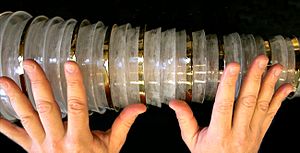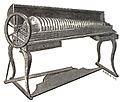Glass harmonica facts for kids
The glass harmonica (also known as the armonica) is a special musical instrument that makes sounds from spinning glass bowls. It was invented by Benjamin Franklin, a famous American inventor and statesman. Imagine a row of glass bowls, like fancy drinking glasses, all lined up on a spinning rod. When the player gently rubs their wet fingers on the edges of these bowls as they spin, beautiful, haunting music is created. Each bowl is a different size, and this difference in size helps create different musical notes, from low rumbles to high, clear tones.
Contents
What is a Glass Harmonica?
The glass harmonica is a unique instrument that belongs to the crystallophones family, meaning it makes sound from vibrating crystals or glass. It's not like a regular harmonica you blow into. Instead, it uses friction to create sound. The instrument usually has a series of glass bowls or goblets, carefully tuned to specific musical notes. These bowls are nested together and mounted on a horizontal spindle.
How Does It Work?
To play the glass harmonica, the musician sits in front of it and uses a foot pedal to spin the spindle, which makes all the glass bowls rotate. Then, they lightly touch the wet rims of the spinning bowls with their fingers. The friction between their wet skin and the glass causes the glass to vibrate, producing a clear, ringing sound. Different notes are made by touching different sized bowls. Larger bowls make lower sounds, and smaller bowls make higher sounds.
Who Invented This Instrument?
The glass harmonica was invented by Benjamin Franklin in 1761. Franklin was inspired by seeing musicians play music by rubbing their fingers on the rims of wine glasses filled with water. He wanted to make an instrument that could play many notes at once, like a piano, but with the unique sound of glass. His invention made it much easier for musicians to play complex melodies and harmonies using glass.
The Sound of the Armonica
The sound of the glass harmonica is often described as ethereal, haunting, or otherworldly. It has a pure, sustained tone that can be very calming and beautiful. Because of its unique sound, it became very popular in the late 1700s. Many famous composers, like Wolfgang Amadeus Mozart and Ludwig van Beethoven, wrote music for the glass harmonica.
Why Was It So Popular?
When it was first invented, the glass harmonica was a sensation. People were amazed by its sound, which was unlike any other instrument. It was played in concerts and even became a popular instrument for people to have in their homes. Its popularity spread across Europe and America.
Decline and Revival
Over time, the popularity of the glass harmonica faded. Other instruments became more common, and some people even believed that the instrument's sound could cause strange effects or even madness, though this was just a myth. However, in recent years, there has been a renewed interest in the glass harmonica. Musicians and instrument makers are bringing it back, allowing new generations to enjoy its magical sound.
Images for kids
-
A glass harp, an ancestor of the glass armonica, being played in Rome. The rims of wine glasses filled with water are rubbed by the player's fingers to create the notes.
-
Part of the original manuscript score of "Aquarium" from The Carnival of the Animals by Camille Saint-Saëns. The top staff was written for the (glass) "Harmonica".
See also
 In Spanish: Armónica de cristal para niños
In Spanish: Armónica de cristal para niños








